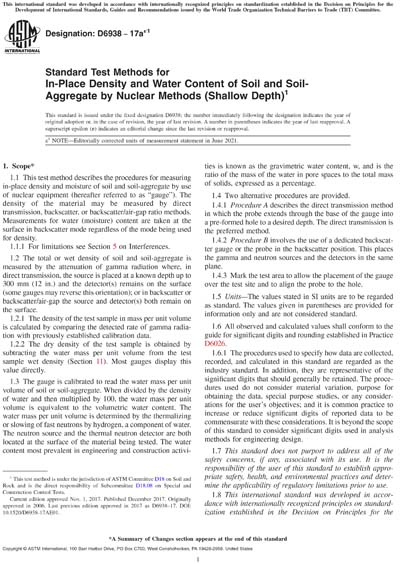Historical
ASTM D6938-17ae1
Standard Test Methods for In-Place Density and Water Content of Soil and Soil-Aggregate by Nuclear Methods (Shallow Depth)
1.1This test method describes the procedures for measuring in-place density and moisture of soil and soil-aggregate by use of nuclear equipment (hereafter referred to as "gauge"). The density of the material may be measured by direct transmission, backscatter, or backscatter/air-gap ratio methods. Measurements for water (moisture) content are taken at the surface in backscatter mode regardless of the mode being used for density.
1.1.1For limitations see Section 5 on Interferences.
1.2The total or wet density of soil and soil-aggregate is measured by the attenuation of gamma radiation where, in direct transmission, the source is placed at a known depth up to 300 mm (12 in.) and the detector(s) remains on the surface (some gauges may reverse this orientation); or in backscatter or backscatter/air-gap the source and detector(s) both remain on the surface.
1.2.1The density of the test sample in mass per unit volume is calculated by comparing the detected rate of gamma radiation with previously established calibration data.
1.2.2The dry density of the test sample is obtained by subtracting the water mass per unit volume from the test sample wet density (Section 11). Most gauges display this value directly.
1.3The gauge is calibrated to read the water mass per unit volume of soil or soil-aggregate. When divided by the density of water and then multiplied by 100, the water mass per unit volume is equivalent to the volumetric water content. The water mass per unit volume is determined by the thermalizing or slowing of fast neutrons by hydrogen, a component of water. The neutron source and the thermal neutron detector are both located at the surface of the material being tested. The water content most prevalent in engineering and construction activities is known as the gravimetric water content, w, and is the ratio of the mass of the water in pore spaces to the total mass of solids, expressed as a percentage.
1.4Two alternative procedures are provided.
1.4.1Procedure Adescribes the direct transmission method in which the probe extends through the base of the gauge into a pre-formed hole to a desired depth. The direct transmission is the preferred method.
1.4.2Procedure Binvolves the use of a dedicated backscatter gauge or the probe in the backscatter position. This places the gamma and neutron sources and the detectors in the same plane.
1.4.3Mark the test area to allow the placement of the gauge over the test site and to align the probe to the hole.
1.5Units - The values stated in SI units are to be regarded as standard. The values given in parentheses are provided for information only and are not considered standard.
1.6All observed and calculated values shall conform to the guide for significant digits and rounding established in Practice D6026.
1.6.1The procedures used to specify how data are collected, recorded, and calculated in this standard are regarded as the industry standard. In addition, they are representative of the significant digits that should generally be retained. The procedures used do not consider material variation, purpose for obtaining the data, special purpose studies, or any considerations for the user's objectives; and it is common practice to increase or reduce significant digits of reported data to be commensurate with these considerations. It is beyond the scope of this standard to consider significant digits used in analysis methods for engineering design.
1.7This standard does not purport to address all of the safety concerns, if any, associated with its use. It is the responsibility of the user of this standard to establish appropriate safety, health, and environmental practices and determine the applicability of regulatory limitations prior to use.
1.8This international standard was developed in accordance with internationally recognized principles on standardization established in the Decision on Principles for the Development of International Standards, Guides and Recommendations issued by the World Trade Organization Technical Barriers to Trade (TBT) Committee.
ASTM International [astm]

